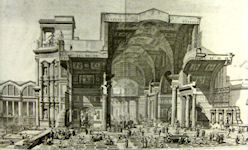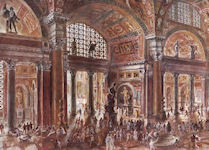Baths of Diocletian
 The Baths of Diocletian are situated at the junction of the Quirinal and Vuninal Hills. These magnificent Thermae were begun by Diocletian and Maximian about AD 302, and finished by Constantius and Maximinus. Cardinal Baronius states, on the authority of the martyrologists, that 40,000 Christians were employed upon the works, and it is added that some bricks have been found bearing the mark of the cross. It is very probable that this tradition led to the consecration of the ruins, and which accounts for the preservation of the finest hall which has been left to us from ancient times.
The Baths of Diocletian are situated at the junction of the Quirinal and Vuninal Hills. These magnificent Thermae were begun by Diocletian and Maximian about AD 302, and finished by Constantius and Maximinus. Cardinal Baronius states, on the authority of the martyrologists, that 40,000 Christians were employed upon the works, and it is added that some bricks have been found bearing the mark of the cross. It is very probable that this tradition led to the consecration of the ruins, and which accounts for the preservation of the finest hall which has been left to us from ancient times.
The Thermae were of immense size, covering a space of 150,000 square yards; and capable of furnishing 3200 baths, being double the number which those of Caracalla, then the largest in Rome, could supply; the ruins, with the buildings surrounding them, cover an area nearly a mile in circuit, including all the space occupied in the mid-19th Century by the Piazza di Termini, the Carthusian convent and its gardens, the convent and gardens of San Bernardo, the public granaries, and prisons.
The buildings occupied a rectangular space, having in front a semicircular projection, with two circular halls at the angles, which opened into the area, the use of which it is difficult to determine. Both of these latter still exist: one forms the modern church of San Bernardo; the other, situated at the corner of the Via Viminale, is much dilapidated and has been converted into the vestibule of the prisons. Between them is the Theatrum, in some parts of which may still be traced the seats for spectators of the exercises of the palaestra, held in the level arena, now the Piazza di Termini.
Between the Theatrum and the two circular halls is the supposed site of the Libraries, to which the literary collections of the Ulpian Basilica had been removed. The main portion of the Thermae, properly speaking, formed an oblong square in the center of the area. The principal entrances were on the N. and S., opening from the streets leading to the Porta Viminalis and Porta Collina. The great central hall was converted by Michelangelo into the noble church of Sta. Maria degli Angeli. Between the cloister and the church are some other ruins, of gigantic size, built of red brickwork, with rows of corbels in stone. Some of the halls still retain part of their vaulted ceilings of immense span ; but being included within the buildings of the neighbouring barracks, and partly occupied by hay magazines, it is almost impossible to obtain a complete survey of the ruins.
 A fanatic Sicilian priest saved the great hall of Diocletian's Baths from destruction in Michelangelo's time. The story is worth telling, for it is little known. In a little church in Palermo, in which the humble priest Antonio Del Duca officiated, he discovered under the wall-plaster a beautiful fresco or mosaic of the Seven Archangels, with their names and attributes. Day after day he looked at the fair figures till they took possession of his mind and heart and soul, and inspired him with the apparently hopeless desire to erect a church in Rome in their honor.
A fanatic Sicilian priest saved the great hall of Diocletian's Baths from destruction in Michelangelo's time. The story is worth telling, for it is little known. In a little church in Palermo, in which the humble priest Antonio Del Duca officiated, he discovered under the wall-plaster a beautiful fresco or mosaic of the Seven Archangels, with their names and attributes. Day after day he looked at the fair figures till they took possession of his mind and heart and soul, and inspired him with the apparently hopeless desire to erect a church in Rome in their honor.
To Rome he came, persuaded of his righteous mission, to fail of course, after seven years of indefatigable effort. Back to Palermo then, to the contemplation of his beloved angels. And again they seemed to drive him to Rome. Scarcely had he returned when in a dream he seemed to see his ideal church among the ruins of the Baths of Diocletian, which had been built, as tradition said, by thousands of condemned Christians. To dream was to wake with new enthusiasm, to wake was to act. In an hour, in the early dawn, he was in the great hall which is now the Church of Santa Maria degli Angeli, ' Saint Mary of the Angels.'
But it was long before his purpose was finally accomplished. Thirty years of his life he spent in unremitting labor for his purpose, and an accident at last determined his success. He had brought a nephew with him from Sicily, a certain Giacomo Del Duca, a sculptor, who was employed by Michelangelo to carve the great mask over the Porta Pia. Pope Pius the Fourth, for whom the gate was named, praised the stone face to Michelangelo, who told him who had made it. The name recalled the sculptor's uncle and his mad project, which appealed to Michelangelo's love of the gigantic. Even the coincidence of appellation pleased the Pope, for he himself had been christened Angelo, and his great architect and sculptor bore an archangel's name. So the work was done in short time, the great church was consecrated, and one of the noblest of Roman buildings was saved from ruin by the poor Sicilian.

|
NEWSLETTER
|
| Join the GlobalSecurity.org mailing list |
|
|
|

